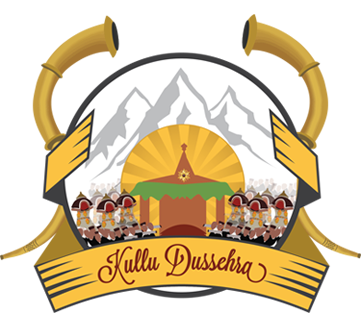A Kullu devata, as we see prominently in melas, fairs, and on other special occasions, decked with a number of attractive mohras (known as face or bust) in metal on a wooden framework and decorated with silken cloth and decorative ornaments, moving with a large retinue of attendants and followers, is a unique cultural creation of the Kullu folk. A devata in vigorous movement amid crowds accompanied by the rapid beating of drums and musical instruments appears to be driven by the force of its own internal energy. This attracts much attention; sometimes even creates fear among some spectators.
A devata can walk, run, take long journeys, go on pilgrimage and go for ritual bathing to holy places riding on the shoulders of two men.
His moods swing from being happy, angry, and sad to sulky. A devata can also fall asleep and wake up. He can answer questions of his devotees; decide disputes, issue judgments and make forecasts, all through the gur, an oracle speaking on his behalf. He also bestows boons and blessings upon the visitors.
A devata may go for meeting with another of his ilk, who may be related to him as a brother, sister, or any other kin; may be his guru, teacher, even. When two devatas meet they seemingly attempt to hug each other. They dance together, walk beside each and even sit together. A devata can go as a guest for feasts on invitation of a devotee, can be a host for another devata and accept offerings and sacrifices. He does most acts a human being can perform. The difference is that his life is perpetual. Thus a fully festooned rath is virtually a living being. Rath adornments like the chhatri or parasol, an ornament of the pheta (slanting) rath, and appearance of the mohras – moustaches, ear-rings, nose-rings – are the distinguishing features between a devata and a devi. Necklaces are common to both. Their heads are decorated with diadems.
The other most attractive article for a viewer, after the rath, is the array of mohras that repose within. A mohra represents not only the face but the entire body of the devata. In it also abides the soul of the devata. Physically a mohra may display the face, neck and chest or breasts. They wear necklaces and sometimes garlands of serpents. Male figures are often depicted with moustaches. Female faces wear pendants, earrings or nose rings. Diadems on their heads exhibit their royal personage. In one case we see a diadem with skulls and palms, displaying his sectarian leaning.
In a rath every mohra is taken as a living object. Of which one mohra is considered chief in which is enshrined the shakti, power, or the soul of the devata or devi. When the devata is in ceremonial dress and on the march, it draws its power from this mohra, which is generally made of bell metal. This mohra is sometimes displayed prominently on the rath among the other mohras and sometimes kept concealed. About its use there are different practices, depending on the devata. Some emphasize that the mohra must be decked in the rath along with the others. It may be displayed prominently, but generally it is kept concealed, wrapped in a cloth. In the case of the pheta rath it may be kept in the lap of the rath. Some others don’t carry it on the rath but keep it in the temple. There too it is kept concealed, in some cases it is kept underground in a pit.
The term mohra when translated means bust, torso, face or mask. Yet a mohra is not made to be worn on the face nor can it be sported elsewhere. They have to be sanctified after they are manufactured. Physically a mohra measures between 20cms and 30cms in height and 12cms to 20cms in width. It is made of cast metal or embossing on sheets of gold, silver, brass and copper. But we see that copper has been used very rarely.
The mohra principally exhibit the face. Older mohras, however, tend to represent a larger part of the body than this. Therefore it may not be inappropriate to designate them as busts. In fact one of the earlier mohras can be seen sporting miniature legs. The modern samples, however, are shorter and appear to be focusing more on the face.
The most valuable among all the mohras of a devata is not that of gold or silver, but that of ashtdhatu (mixture of eight metals) as it is no longer used, not even by newborn devatas themselves.


